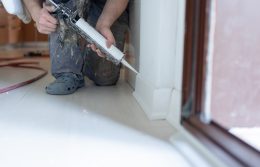A Complete Guide to Winterizing Your Home
If you feel a draft creeping through your home, it’s time to winterize. Just as you dig out warm sweaters and blankets, stock up on marshmallows and hot cocoa, and bring in firewood for the season, your home needs some extra attention to get through the winter months. Winterizing your home will help keep your family cozy and save you in energy costs. Here’s where to start:
Packing Up Outdoors
- Winterize your pool. If your pool water freezes, that can do major damage. Depending on your area, different levels of winterizing may be necessary.
- Inspect your roof for leaks well before inclement weather arrives.
- Make sure gutters aren’t loose or sagging, as the weight of snow or ice can pull them loose.
- Winterize your garage.
- Drain water out of pipes and shut off the water supply valve if you leave town. Cover vulnerable outdoor pipes with insulated sleeves made of foam rubber or fiberglass.
- Paint exteriors as needed.
- Store hoses, removing from exterior faucets and making sure water is drained from sprinkler heads.
- Store outdoor furniture. Clean and vacuum any outdoor pillows, cushions, and umbrellas before storing them in a dry area to protect them from mold growth. Move wooden, metal, and wicker pieces into a protected garage or shed. A coat of automotive wax can protect metal furniture.
- Clean and store tools you won’t need until your next foray into the garden.
- Clean out boats. Don’t leave them to the whims of winter. Air out life jackets, fill the tank with a fuel stabilizer, and spray the engine with oil to prevent rust.
Wrapping Up Indoors
- Check your insulation for any gaps you may need to fill.
- Dial your thermostat to above 65 degrees to prevent pipes from freezing, bursting, and causing water damage.
- Add fresh caulk around windows and doors to seal up cracks and holes. To fix holes around plumbing pipes in the attic, fill the hole with fiberglass insulation and seal with spray foam.
- Check weatherstripping around windows and door frames is tight and in good condition. The U.S. Department of Energy offers a great chart to help you choose, from an aluminum door sweep to foam tape that seals windows.
- Inspect window frames for rot or decay. This can lead to structural damage and compromise the frame’s ability to keep out cold air and moisture. Check the glass for cracks, gaps, and broken areas, and replace or repair.
Warming Up Safely
- Make sure fireplaces and chimneys are safe. Think of a roaring fireplace like a campfire in your living room, and treat it with the same reverence.
- Make sure fire safety measures are in place.
- Inspect your water heater and furnace. They’re your first line of defense against the cold. Call in the experts to ensure your HVAC system is clean, ventilated, and in good status. You may need to clean or replace the air filter and flush your water heater tank to get rid of sediment and increase efficiency.
- Store generators and other such equipment outside the house.
- Use caution with electric blankets and other heated bedding. They have great snuggling appeal but come with fire hazards.
Preparing for All Weather
- Make sure you stock up on the essentials in case of bad weather. Follow this guide to a successful evacuation plan and kit.
- Your family should have a customized fire escape plan, as well.
Call your Texas Farm Bureau Insurance Agent if you have any questions about your property insurance. A 360 Review is a great way to make sure you have the coverage you need and give yourself peace of mind for the season ahead. Learn more about protecting your home this winter with tips for decking the halls safely.
Coverage and discounts are subject to qualifications and policy terms and may vary by situation. © 2016 Texas Farm Bureau Insurance



